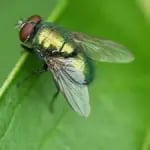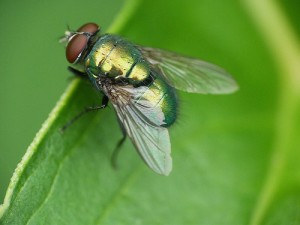Controlling Flies in Your Home and Yard

What’s a barbecue or picnic without a few flies, right? Wrong. The flies you nonchalantly swat from your burger and cole slaw can make you sick. These flies, known as filth flies, make a living off animal feces and garbage. Flies pick up all manner of nasty bacteria, then transport the disease-causing organisms right to your food. Take a few measures to control flies in your backyard and your home, and you’ll be healthier for it.
What Are Filth Flies?
 Filth flies carry disease-causing organisms and can be a threat to public health. These flies breed in bacteria-laden environments, such as feces, carrion, and human food waste, often in close proximity to humans or domesticated animals. Filth flies include some of our most common fly pests — house flies, fruit flies, green bottle flies, stable flies, and several others.
Filth flies carry disease-causing organisms and can be a threat to public health. These flies breed in bacteria-laden environments, such as feces, carrion, and human food waste, often in close proximity to humans or domesticated animals. Filth flies include some of our most common fly pests — house flies, fruit flies, green bottle flies, stable flies, and several others.
A single house fly can carry over one million bacteria. No less than 60 different diseases can be transmitted by filth flies, from salmonella to dysentery. Most filth flies can reproduce quickly in warm weather. To keep fly populations under control, you must limit the places where they can breed and feed.
Good Sanitation Practices to Reduce Flies
There’s nothing a filth fly likes less than proper sanitation. Adult flies need a place to lay their eggs, and a clean home and yard just won’t appeal to mama fly. Here’s how to keep flies from breeding in or near your home.
- Clean up all pet and animal feces promptly. Any fresh, moist animal feces will draw flies. To keep flies from breeding in your dog’s doo-doo, either bury it immediately or use a pooper scooper and plastic bag to remove and seal the feces. Place the bagged waste in a lidded garbage can.
- Dispose of kitchen scraps and other organic waste properly. When it comes to food waste, the drier the better. Drain any moisture you can from it before throwing it away. Scrape your plates or other leftovers into a plastic garbage bag, tie the bag shut, and put it in a garbage can with a tight fighting lid.
- If you save kitchen waste for your compost heap, add some sawdust to your scrap bin to help absorb moisture and odors that might attract flies. If your compost pile does not heat up sufficiently, those kitchen scraps may attract breeding flies. Turn your compost pile regularly, and don’t put meats or animal waste in your compost bin.
- Garbage cans and dumpsters are favorite breeding areas for flies. You can significantly reduce fly populations by keeping lids tightly closed on your trash cans, and making sure the cans have no holes. All garbage within the can should be bagged and tied closed. Don’t forget to put your garbage out for collection regularly. It’s not a bad idea to scrub out your cans now and then, to remove any food or pet waste residue.
- Recycling cans also attract some filth flies. Rinse empty soda cans, beer bottles, and pet food cans before tossing them in the recycling. If possible, use a lidded recycling container.
- If you have fruit trees in your yard, pick up any fruit that falls on the ground. Fermenting or overripe fruit provides just the right combination of moist and sweet to attract flies.
- Indoors, take care not to overwater your houseplants. Prune and discard of any dying plant parts. Fungus gnat larvae feed on fungi that develops in moist soils and on decaying plant matter.
Physical Controls for Filth Flies
Following all the sanitation rules above will significantly reduce, but not completely eliminate, flies in your yard and home. You can further limit the numbers of these unhealthy pests by using appropriate barriers and traps.
- Install and maintain tight-fitting window screens. Check your screens for holes or tears, and repair them as needed. Caulk and seal any openings around windows, doors, or in your foundation.
- Sticky fly paper does work, but is most useful when fly populations are low. If you’ve followed all the steps to limit breeding sites, hanging a few sticky fly paper traps will do the trick on the few that wander into your home. Still, you might not like having a ribbon of dead flies hanging from your ceiling.
- Commercially available fly traps work well, especially for house flies. Traps usually contain some kind of food bait, sometimes in combination with a pheromone. Place fly traps where you see the most flies.
Pest Control for Flies
Proper sanitation is the best way to keep flies to a minimum, but if these tips are not enough to keep you summer season fly free, then a pest control professional might be your best choice.Green Pest Solutions is a recognized leader in the pest management industry in the Philadelphia and the surrounding areas. We offer the best in fly, mice, rat , rodent, pest and termite control services using traditional treatment methods and green products.
Article originally posted here. Written by Debbie Hadley.